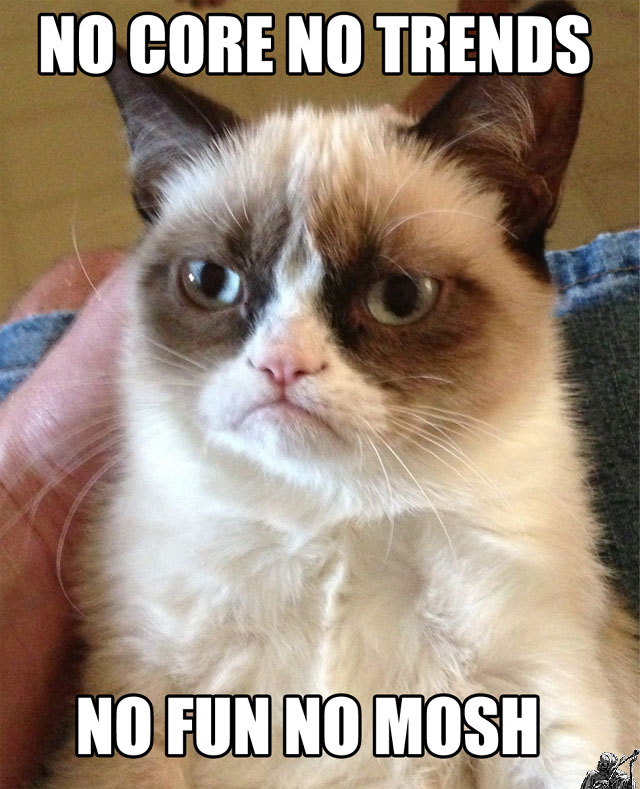
Standard Whore (Demilich)
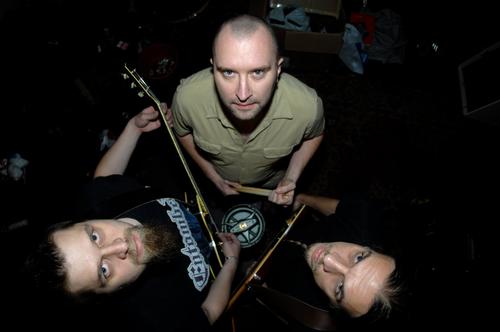
Continuing our series of metalcore bands, a brief look at Standard Whore shows us an exceptional version of the modern metal style combined with a guitar rock outlook.
From the mastermind guitarist and drummer of Demilich, this style in post-Gorguts Obscura era metal hybrids uses the post-hardcore tendency to string together surprising and alarming riff combinations with a stoner rock or guitar rock tendency to stitch it all into a big jam session. One thing’s for sure: if you’re looking for metal, look elsewhere.
The same quirky riffing that made Demilich distinct is here but with more groove, less complexity, and its weirdness has been redirected to a sense of catch and hooky sounds. The result is really easy to listen to, and joins other mostly-instrumental projects like Blotted Science in trying to forge a new late model of the old influences.
Boman’s guitar is the organization voice here and gives to this style a new dimension into which it could expand, which is to remove the pretense of deconstruction and allow a jam to bleed itself together out of these spacy riffs and tortuous tempi.
Somehow I missed this back in 2010, but it’s good to give it some air and light now. These songs are from a live rehearsal session featuring material written 2008-2010.
http://www.youtube.com/watch?v=IzBwprczDm4&feature=related
http://www.youtube.com/watch?v=XjyyKaOw3sI&feature=related
http://www.youtube.com/watch?v=Dimd6hqsaDk&feature=related
http://www.youtube.com/watch?v=pThtiIE3RKE&feature=related
http://www.youtube.com/watch?v=6OhS5JSFLCs&feature=related
http://www.youtube.com/watch?v=KBa6i9aE1kc&feature=related
4 CommentsTags: Demilich, metalcore, standard whore
Profane Prayer – Tales of Vagrancy and Blasphemy
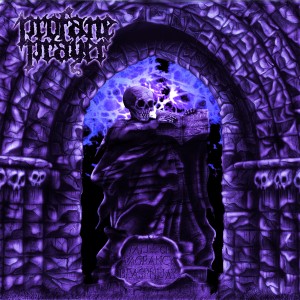 One of the things that distinguished Norwegian black metal from what had preceded it was its emphasis on storytelling: inviting the listener to not just observe, but be an active participant in discovering the meaning behind the work. The elements of composition were not, in themselves, the end goal of a song, but rather were tools used to convey the artist’s intention.
One of the things that distinguished Norwegian black metal from what had preceded it was its emphasis on storytelling: inviting the listener to not just observe, but be an active participant in discovering the meaning behind the work. The elements of composition were not, in themselves, the end goal of a song, but rather were tools used to convey the artist’s intention.
By using heroic imagery coupled with atonal yet melodic music, it went beyond the violent deconstruction of death metal by showing not only that the supposed progress of the modern era has been a sham, it offered an alternative: a return to an earlier age, a time when survival depended upon more than earning enough money to purchase antidepressants and microwave dinners.
This core of black metal was something that was increasingly lost as the genre became more popular, as newer bands overlooked this when attempting to understand how to play this genre of music.
As one of these contemporary bands, Profane Prayer plays black metal in the later Darkthrone style with an old school heavy metal influence. Indicative of its generation, this track (taken from their upcoming album) at first glance has all the elements of black metal: screaming vocals, pounding blastbeats, dissonant tremolo picking, and anti-christian themes.
However, what is lacking is the artistic vision the presages its creation. Although all of the individual components may be sound, there is nothing linking them together. Sections of the song are easily recognizable and there is care in how they are ordered, but the song does not challenge the listener to discovery. Like most black metal of its age, it’s not awful, but not particularly good either. If this band could couple their musical talent with a deeper artistic spirit, they would assuredly have a worthwhile composition.
Tales of Vagrancy and Blasphemy will be released via No Colours Records the first week of May.
4 CommentsTags: Black Metal, profane prayer
Suicidal Tendencies – 13
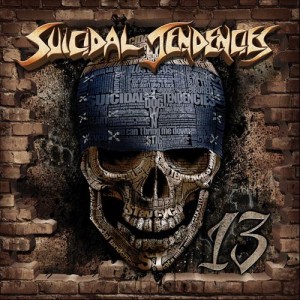 The problem with success is that it can become a cage: you get known for doing something that meant a lot to you at the time, but time goes on. You want new horizons. It’s hard to express them, and you see others succeed for doing a lot less.
The problem with success is that it can become a cage: you get known for doing something that meant a lot to you at the time, but time goes on. You want new horizons. It’s hard to express them, and you see others succeed for doing a lot less.
Suicidal Tendencies launches 13 into a time where metal and punk have both decided to commit suicide by melding so extensively with other genres as to lose their own identities. Melding itself isn’t bad, but when a whole genre does it, it essentially obliterates its unique voice and makes itself another flavor of rock music.
13 escapes Suicidal Tendencies’ past by mixing in a number of alternative, improvisational and extrinsic styles. In particular, you’ll hear island-based world music, Rage Againsst the Machine, and even the keg-party reggae-influenced rock of bands like Sublime, all mixed into what’s essentially a punk band playing metal. The locus of the action has changed: where the original Suicidal Tendencies want to make a point with its songs, these songs want to set up a convivial atmosphere and into that speak some ideas with lyrics. The original songs resembled their content; these songs are a mixture of fun and diverse elements, and expression occurs in the lyrics.
With this album, Suicidal Tendencies demonstrate how an album can be quite good and not satisfy its original audience. I think this will be a huge hit among the alt-rock and nu-metal crowds because it’s more musically interesting than most of the kiddie music. It’s based on firm grooves, catchy melodic vocal hooks, and an insanely over-the-top constant lead guitar jam that gives this music a breadth that is rarely found in music you hear on the radio.
However, for metal fans this one is going to be a failure. It has lost the metal spirit, and it essentially party rock with some metal riffs. The cool guitar work and occasional shredding give this some power, but it doesn’t switch it to the viewpoint a metal fan will appreciate.
9 CommentsTags: suicidal tendencies, Thrash
Ara – The Blessed Sleep
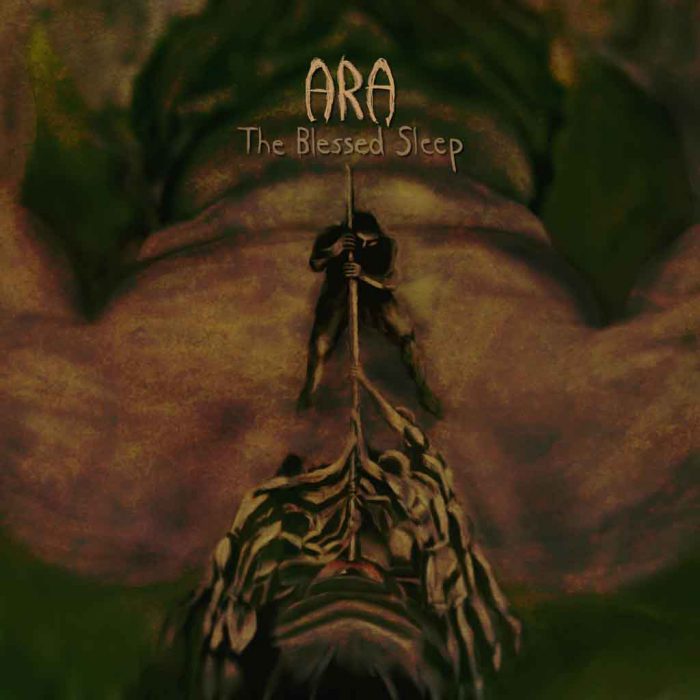
During the past decade, a number of bands have tried to reign in the genre from its Necrophagist-style peak of unrelated technical fireworks to more of the songwriting that made bands like Botch, Human Remains and Rites of Spring influential founders of the genre.
With The Blessed Sleep, Ara steps up to the plate by streamlining the genre and removing the unrelated parts, which keeps a focus on songwriting like Harkonin or Neurosis. This eliminates the biggest problem, but for those who don’t like metalcore, it leaves the tendency to scream out lyrics in a trope of regularity and a fascination with “different” riffs and surprise twists that often leads toward a predictability of being unpredictable. (Imagine a general on the battlefield who maintains an advantage by being unpredictable. After a while, it becomes random, and easier to respond to because there is no expectation otherwise.)
The Blessed Sleep attempts to work around these challenges to the genre by varying tempo and the texture of riffing, stacking subtly melodic arpeggios up against chromatic chugging riffing, and by not using any single technique constantly (except the angry-man-in-a-phone-booth vocals). The result is far more listenable and develops actual songs that, although based on jarring contrast, are able to return to a single pair of themes and develop variation there.
Although Ara are touted by many as technical, nothing here is particularly technical as in specific skills, but putting these songs together without them falling apart and playing them on the nose will be difficult for any but a professional and experienced band. The streamlined songwriting, topicality and focus make The Blessed Sleep one of the more intense tech-deth albums to emerge in recent years.
104 CommentsBlack Sabbath announce US tourdates for new album “13”
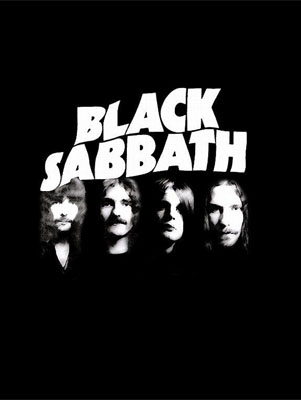 Seminal heavy metal band Black Sabbath has released the first single from their upcoming album, 13. Entitled “God Is Dead?”, it features 3/4 of the iconic Sabbath lineup.
Seminal heavy metal band Black Sabbath has released the first single from their upcoming album, 13. Entitled “God Is Dead?”, it features 3/4 of the iconic Sabbath lineup.
While still possessing the distinctive Sabbath sound, it is clear that this is a song produced in the commercial hard rock vein, rather than a unique artistic statement as was their original work.
Even done relatively well, it’s not the Sabbath of lore and must be viewed in a different light than the original era. Forty-three years after the band’s debut, it is not unexpected that they might alter their sound somewhat.
Releasing their debut self-titled album in 1970, Black Sabbath were the first “proto-metal” band in that they used the movable form of the power chord to make riffs that slid down the fretboard and thus encouraged songwriting with longer phrases, more atmosphere and a more flexible rhythmic attack than the rock music of the day. Distinguishing themselves with a number of chart-toppers as well as an audience who craved more, Black Sabbath kicked off the metal genre which quickly differentiated itself from rock and became a subcultural movement in its own right.
13 is due to be released on June 11 and the band will be reaching North America later in the year. Initial tour dates have been announced as follows:
- 8/4 — Holmdel, N.J. — PNC Bank Arts Center
- 8/14 — Toronto, Ontario — Air Canada Centre
- 8/24 — Seattle, Wash. — Gorge Amphitheatre
- 9/3 — Los Angeles, Calif. — Los Angeles Sports Arena
Tags: black sabbath, Heavy Metal
Autopsy “The Headless Ritual” coming this July, Cover art and track list revealed
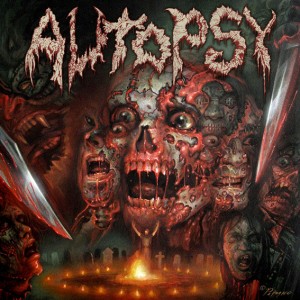 This July 2, Autopsy returns with their sixth studio album of horror and gore inspired death metal, The Headless Ritual.
This July 2, Autopsy returns with their sixth studio album of horror and gore inspired death metal, The Headless Ritual.
Featuring the returning quartet of Chris Reifert, Eric Cutler, Danny Coralles, and Joe Trevisano, The Headless Ritual explores the all-out sonic assault of and varied tempos that made Autopsy famous as a death metal band with variation. The album was recorded and mixed April 2013 at Fantasy Studios, San Francisco, Calif. with Adam Munoz, and features cover artwork by renowned artist Joe Petagno (Motörhead, Pink Floyd, Led Zeppelin) and will be released on Peaceville Records.
Drummer/vocalist Chris Reifert said, “Expect nothing less than the monstrous brutality that Autopsy has been known to offer. Laurels will not be rested upon, trends will not be followed and mercy will not be shown. Mark your calendars for June and pick out a coffin to lie down and die in. Darkness and death await…”
Autopsy formed in 1987 in the San Francisco Bay Area and released four albums on Peaceville Records, beginning with Severed Survival (1989) and peaking with Mental Funeral (1992), which many acknowledge as their best work. After disbanding in 1995, Autopsy returned in 2010 with the EP The Tomb Within, followed by the release of the band’s fifth studio album Macabre Eternal the following year.
1. Slaughter at Beast House
2. Mangled Far Below
3. She is a Funeral
4. Coffin Crawlers
5. When Hammer Meets Bone
6. Thorns and Ashes
7. Arch Cadaver
8. Flesh Turns to Dust
9. Running From the Goathead
10. The Headless Ritual
For more information, see the official Autopsy website or the mini-site on Peaceville Records.
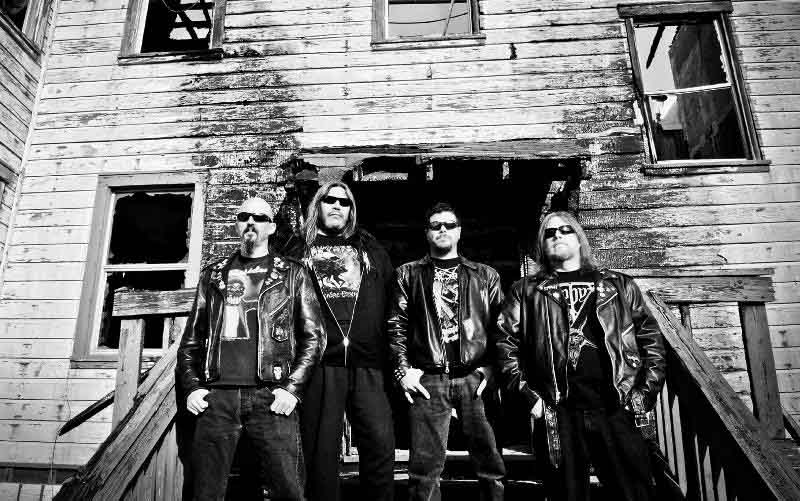
Tags: autopsy, death metal
Analyze It To Life: Black Sabbath – God Is Dead?
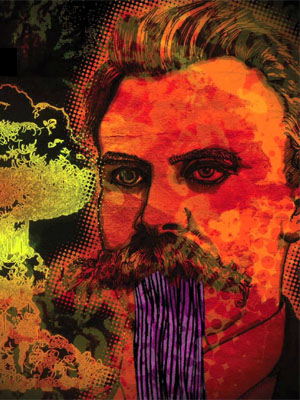 I’ve been listening to “God Is Dead?”-the first single off Black Sabbath’s new album 13, since yesterday. It’s really good and really Sabbath. I’m obsessing. And maybe I’m a rabid fan who’s lain in wait and whose enthusiasm has gotten the better of him. But this is enlivening me in the way only music can. So, I’m going to return the favor and Analyze It to Life.
I’ve been listening to “God Is Dead?”-the first single off Black Sabbath’s new album 13, since yesterday. It’s really good and really Sabbath. I’m obsessing. And maybe I’m a rabid fan who’s lain in wait and whose enthusiasm has gotten the better of him. But this is enlivening me in the way only music can. So, I’m going to return the favor and Analyze It to Life.
I’ve been waiting for this all this time. I’m not disappointed at all. But in a way we have two songs here. The first 4:00 or so are great. Wilk’s drumming is Ward-esque in places and seems almost respectful of Bill’s sound somehow, especially at :30 behind those power chords that hit us in the face–a taste of what’s to come. But it’s not quite the Sabbath I was waiting for–yet. The vocal starts, sounding a bit like an Ozzy song, perhaps because he doesn’t have the pipes he did 40 years ago. I’m glad he made the adjustment and went with his current ability. Ronnie did that on The Devil You Know too. It’s the right choice. The lyrics are super dark and REALLY like the old Sabbath. Tony and Geezer are holding back. I’m still waiting for it. I still needed some Sabbath in my Sabbath. Then the chorus hits at 2:16 and at 2:26 that super-doomy descending lick hints at the Sabbath sound. It made my heart go faster. The entire chorus is the doomy, Sabbathy sound I want. But they are still holding back. It’s clean. It’s not quite Sabbath yet.
Then they go back for the next verse. It’s more intense now because the chorus has put us on notice. Something is coming after this second verse.
WOW! Does it come! At 4:05 that Sabbath discord starts in behind the verse “When will this nightmare be over? Tell me!” But musically, the nightmare is beginning. Did they mean to do that? Anyway, in my 35 years of listening to Black Sabbath, Tony has seldom used discord just to use it. It’s a signal. And THEN, right AFTER “Tell me!” at 4:09-4:10, it all changes and becomes Black Sabbath and never turns back. Tony does what only he does. If you’ve seen them live or on video, you will see him slide up and “shake” the chord. I don’t know of anyone that does that. All this time, all these guitarists, and ONLY Tony Iommi does that. Then after the lyrics “When can I empty my head?”–a classic Iommi riff (4:17-4:18), then a reprise of the aforementioned descending lick, and an expansion the power chords at 4:10 into back-and-forth riffing that makes us want to erupt. It’s a crescendo, really (that doesn’t stop, this riff actually takes over the song here). The lyrics ask “Is God really dead?”; the music behind it screams “ANSWER THE QUESTION”!
NOW, that riff churns forward, pushing. We were invited to listen until 4:10. We are being compelled now. This is classic Black Sabbath. That relentless, hypnotic intensity that won’t let go. At 5:38 we get to the chorus with that descending lick again. Then at 5:48 they reprise the power chords from :30 into the song. It’s a set up.
These chords are a bridge to the break at 6:19. This break is amazing. It seems like something off the first album or Vol. 4 (or Falling off the Edge of the World off Mob Rules). The guitar starts it. all by itself. It’s CLASSIC SABBATH. The at 6:27 Geezer Butler kicks it into high gear. He never lets up. He proves once again that he is the king of metal bassists. Another verse soars above the chugging riffs. All the musicians are doing the same thing. CLASSIC, CLASSIC, CLASSIC SABBATH. Then the chorus again, but under it Geezer starts what will be one of the best performances on bass guitar–I’m going to say it–anywhere in the Black Sabbath oeuvre. It’s relentless and never really stops. Even when the songs slows, his playing does not. He’s the unsung hero of this band. I would put him up against anyone playing bass today, in any genre. The solo has a 60’s sound to it. It’s not very long-about 15 seconds (7:38–7:53). In fact, it’s bluesy. What an interesting choice. I think it’s perfect. I can see how it would have been cool to extend it a bit, but the musicianship and intensity so far have been so powerful that a solo isn’t needed for the song to have a high point. In fact, Geezer’s playing behind the solo is almost soloing itself. He’s playing much faster than Tony.
We have a minute left. The exeunt is the descending lick behind repeated “God is dead” chorus. Solid, unified wall of sound-classic Sabbath. The chorus leaves us with a rather definitive statement “I don’t believe that God is dead.” Then it stops.
There is surely a strong Ozzy aesthetic early in the song. I’m glad for it really. We’re used to Ozzy, and it’s a comfortable start. Wilk is no Bill Ward, but he really does very well here, and at times, as I mentioned, he pays homage to him. But the first four minutes are a build up, like a prerequisite course. The rest of the song is pure Black Sabbath. Tony and Geezer are as good as they ever were.
I don’t believe that Black Sabbath is dead. I believe they are more alive than ever.
Originally posted on Prof. Jacobsen’s Facebook Notes page. Reposted with permission and gratefully used.
1 CommentTags: black sabbath, Heavy Metal, proto-metal
Plants flourish under heavy metal more than other genres
 A horticultural student wanted to find out about the effects of music on the growth of plants, so they were tested with classical music, silence, Cliff Richard and Black Sabbath. The plants hearing Black Sabbath thrived and surprisingly, were also the most disease-resistant.
A horticultural student wanted to find out about the effects of music on the growth of plants, so they were tested with classical music, silence, Cliff Richard and Black Sabbath. The plants hearing Black Sabbath thrived and surprisingly, were also the most disease-resistant.
“And the ones with Black Sabbath – great big, thumping noise, rowdy music – they were the shortest, but they had the best flowers and the best resistance to pest and disease,” said garden guru Chris Beardshaw.
According to the researchers, the plants were subjected to high-intensity sound for the duration of their lives in the nursery. “It was alstroemerias we were growing and we bombarded these glasshouses with sound for the life of the plant,” said Beardshaw. Of the types of music, Black Sabbath produced the biggest flowers, and those plants exposed to Cliff Richard died.
This is no surprise to metal fans, who note that metal has some of the greatest depth of mood and power in all of music, mainly because most music focuses on only one or two moods to make its ego-centric love songs palatable. “Plants love heavy metal,” said the BBC Gardens expert.
5 CommentsTags: Heavy Metal, plants
Black Sabbath – God is Dead?
 Lost in the darkness
Lost in the darkness
I fade from the light
Faith of my father, my brother, my Maker and Savior
Help me make it through the night
Blood on my conscience
And murder in mind
Out of the gloom I rise up from my tomb into impending doom
Now my body is my shrine
The blood runs free
The rain turns red
Give me the wine
You keep the bread
The voices echo in my head
Is God alive or is God dead?
Is God dead?
Rivers of evil
Run through dying land
Swimming in sorrow, they kill, steal, and borrow. There is no tomorrow
For the sinners will be damned
Ashes to ashes
You cannot exhume a soul
Who do you trust when corruption and lust, creed of all the unjust,
Leaves you empty and unwhole?
When will this nightmare be over? Tell me!
When can I empty my head?
Will somebody tell me the answer?
Is God really dead?
Is God really dead?
To safeguard my philosophy
Until my dying breath
I transfer from reality
Into a mental death
I empathize with enemy
Until the timing’s right
With God and Satan at my side
From darkness will come light
I watch the rain
And it turns red
Give me more wine
I don’t need bread
These riddles that live in my head
I don’t believe that God is dead
God is dead
Nowhere to run
Nowhere to hide
Wondering if we will meet again
On the other side
Do you believe a word
what the Good Book said?
Or is it just a holy fairytale
And God is dead?
God is Dead x4
Right!
But still the voices in my head
Are telling me that god is dead
The blood pours down
The rain turns red
I don’t believe that God is dead
God is Dead x4
Lyrically, it reminds me of “After Forever” but a bit more world-weary. Musically, it contains several allusions to past Sabbath and solo work by its members.
Thematically, it seems to me a response to black metal. Was Nietzsche’s target God, or our tendency to say nice things to each other and conceal the essential truth of the challenges before us? There are often many problems, but one root cause. If you don’t strike at that root cause, you get lost. If the problem is man, and not God, and society (collection of humans) instead of some external scapegoat, then we have a greater struggle than can be fixed by burning churches.
Black metal was purely Nietzschean in that it rejected the idea of a moral society and replaced it with the notion that the natural order of Darwinism produced better results. All of the Nietzschean tropes come out: praise of winter, of hardness, of privation, of wolves and of combat and struggle.
Black metal faltered in the mid-1990s when the bands realized that they might have missed their real target, which is something more like people socializing with each other and thus concealing unpleasant truths. While there are other intermediate and proximate causes of the problems we find it this world, the root cause often gets overlooked. That isn’t to say those other causes are good, or shouldn’t be fought in some form or another, just that they’re not the cause.
Black Sabbath is asking “Is God Dead?” and responding in the negative, pointing out that perhaps that last fifteen years of metal have been barking up the wrong tree. The first half of the song is questioning and self-centered, a personal drama. The second half, after the question is posed, is a thunderous rejoinder. The song splits on themes: the wine, the voices that fill the head (he cannot “empty his head”), the lack of any holiness outside the body that is the shrine, and the sense of a “mental death.” On the other hand, there is belief, a pervasive sense of something not fitting together with the narrative of the voices in his head.
Much is left ambiguous by this. “With God and Satan at my side” suggests a type of esotericism that mainstream Christianity will not embrace, and although there are references to the “Good Book,” a particular denominator has not been mentioned. However, the conflict between logic and intuition rises strongly in this song. On one side, there are empirical forces at work; on the other, instinct and a gut feeling. The song ultimately concludes with the idea that God is not dead.
And all of this happens under a banner formed of (a) a dour Friedrich Nietzsche and (b) a nuclear blast. This reminds me of not only black metal’s Nietzscheanism, but its apocalyptic viewpoint. In bad times, people start to get serious again about what they’re doing. Part of getting serious was, at least for black metal and probably for old Black Sabbath, rejecting what is popular and social.
Black metal is uncompromisingly against what makes people comfortable. In Until the Light Takes Us, musicians from Burzum and Darkthrone describe how they tried to get “bad” production for their music, to make it sound old and rotted. How they embraced evil imagery and acted out the most extreme things possible. This wasn’t a rejection of Christianity; it was a rejection of the social impulse behind civilization that prizes what looks/feels good to a group, to what is true — something that generally can be known by only a few, in the Nietzschean sense of the “apex predators” who have through natural selection risen above the rest and can see through a noble light how aggression is central to life.
Black metal may be anti-Christian, but more, it’s about the potentially mind-warping effects of socializing with others. Black Sabbath seems to be suggesting a new direction, which is less toward atheism and Nietzsche, and more toward sacrality, to which black metal might then respond that sacredness itself is what gets destroyed by socializing with others and obscuring the truth. This mirrors where a lot of the black metal guys went after the movement — Beherit to Buddhism, Darkthrone to cosmic space music, Varg to esoteric nationalism, the Graveland guys to folk music, and many others moving on to esoteric sounds like Jaaportit or Vinterriket.
Although they’d probably kill me for saying this, black metal people are generally the most religious people in the room. They believe that life is sacred, that forests are sacred, and that if nature is “red in tooth and claw” and life is “nasty, brutish and short,” that these are manifestations of the divine as well. Far from being “god is dead” people, black metal musicians strike me as being “we are worshipping the wrong god” people.
Hegel would argue that history moves through new ideas, their opposites, and compromises (synthesis). I would argue that history moves by the ideas created through a type of play acted out by characters representing extremes. In this, black metal shows us the antisocial, and Black Sabbath comes out for the sacred; the two will find common ground, because metal is ultimately sacred music. It worships power, death, nature and violence while others prefer pretty flowers and prancing kittens, but only one of those two perspectives embraces all of reality, while the other requires a social filter to merely exist. Black Sabbath and black metal are united in their dislike of that social filter.
27 CommentsTags: Black Metal, black sabbath, Heavy Metal, Religion

